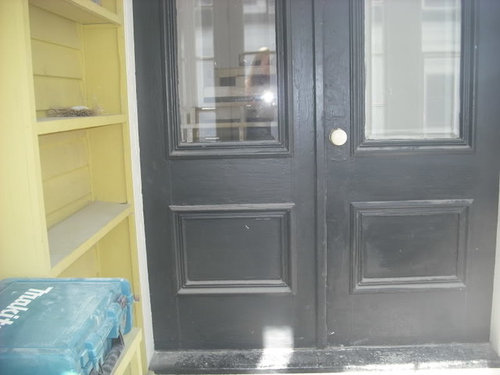Very Newbie question - what would you do with these doors?
kpaquette
15 years ago
Related Stories

DOORS5 Questions to Ask Before Installing a Barn Door
Find out whether that barn door you love is the right solution for your space
Full Story
KITCHEN DESIGN9 Questions to Ask When Planning a Kitchen Pantry
Avoid blunders and get the storage space and layout you need by asking these questions before you begin
Full Story
REMODELING GUIDESPlanning a Kitchen Remodel? Start With These 5 Questions
Before you consider aesthetics, make sure your new kitchen will work for your cooking and entertaining style
Full Story
LANDSCAPE DESIGN7 Questions to Ask Before Laying Stepping Stones
These broken-up pathways invite you to put a spring in your step — while adding functionality to the garden
Full Story
EXTERIORSCurb Appeal Feeling a Little Off? Some Questions to Consider
Color, scale, proportion, trim ... 14 things to think about if your exterior is bugging you
Full Story
FEEL-GOOD HOMEThe Question That Can Make You Love Your Home More
Change your relationship with your house for the better by focusing on the answer to something designers often ask
Full Story
REMODELING GUIDESConsidering a Fixer-Upper? 15 Questions to Ask First
Learn about the hidden costs and treasures of older homes to avoid budget surprises and accidentally tossing valuable features
Full Story
MOST POPULAR8 Questions to Ask Yourself Before Meeting With Your Designer
Thinking in advance about how you use your space will get your first design consultation off to its best start
Full Story
SELLING YOUR HOUSE15 Questions to Ask When Interviewing a Real Estate Agent
Here’s what you should find out before selecting an agent to sell your home
Full Story
WORKING WITH PROS12 Questions Your Interior Designer Should Ask You
The best decorators aren’t dictators — and they’re not mind readers either. To understand your tastes, they need this essential info
Full StoryMore Discussions










bobismyuncle
Jon1270
Related Professionals
Bellwood Cabinets & Cabinetry · Carol Stream Carpenters · Jamaica Plain Carpenters · Hubert Flooring Contractors · Kendall West Flooring Contractors · Louisville Flooring Contractors · Riverhead Flooring Contractors · Saugus Flooring Contractors · Charleston Furniture & Accessories · Greenville Furniture & Accessories · Kirkland Furniture & Accessories · Roswell Furniture & Accessories · Chaska Furniture & Accessories · Genova Furniture & Accessories · Hoboken Furniture & AccessorieskpaquetteOriginal Author
bobismyuncle
bobismyuncle
brickeyee
kpaquetteOriginal Author
jrice
cabman
kpaquetteOriginal Author
kpaquetteOriginal Author